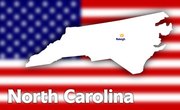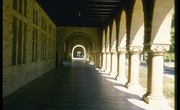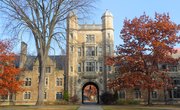Congratulations on graduating! Now that you are beginning to consider colleges, there are many noteworthy differences when public and private universities are compared. Private educational institutions usually offer scholarships and financial incentives to stellar students. If you are planning on attending a private university, do a little homework before tackling the entry paper work and required essay.
Stanford University
Located in Stanford, California, the college is home to nearly 17,000 students each year. Its acceptance rate hovers at 5 percent, making it one of the most competitive schools to get into – only a few more than 2,000 students are admitted to its sprawling campus. The average high school GPA is 4.18 of admitted freshman enrollees. Most freshman have an SAT range of 1430 to 1590, and an ACT score of 31 to 35. Test scores are required for admission.
Massachusetts Institute of Technology
With just over 11,000 enrollees, the Massachusetts Institute of Technology has an acceptance rate of 8 percent annually. About one in 10 applicants receive an acceptance letter. Founded in 1861 in Cambridge, Massachusetts, MIT is ranked #5 in National Universities and has the same ranking for Best Value Schools. The entire application process is completed through the MIT website with a fee of $75.
Harvard University
Also located in Cambridge, Harvard hosts more than 20,000 enrollees. Established in 1636, it is the oldest higher education institution in the United States with the largest academic library in the world. Its acceptance rate hovers around 5 percent with the average high school GPA at 4.04. SAT requirements are in the 1480 to 1600 range and ACT requirements are in the 32 to 35 range.
Yale University
More than 12,000 students call Yale home on a full-time basis. Nearly 2,000 new students are accepted each year. The New Haven, Connecticut, school with its ivy-clad walls has a 6.3 percent acceptance rate. Getting in requires an SAT score of 1470 to 1600 and an ACT range of 32 to 35. Its most popular area of study is social sciences.
Rice University
This Houston-based university has a higher acceptance rate of most top-10 private universities at over 15 percent annually. The SAT range is 1460 to 1580 and the ACT is 32 to 35. The four-year private nonprofit college offers 47 majors and has a class ratio of fewer than 20 students per professor in 70 percent of its classes.
University of Pennsylvania
Nearly 25,000 students roam the manicured grounds of the University of Pennsylvania. It has an acceptance rate of more than 9 percent with 97 percent of new enrollees coming from the top 10 percent of their high school graduating class. It has a student-to-faculty ratio of 6-to-1, with 58 percent of students using some form of financial aid to attend this Ivy League school.
Princeton University
A relatively small student body at just above 8,000 makes Princeton a goal for many students. Nearly 30,000 people apply each year, but only about 2,000 are admitted. The suburban campus was founded in 1746 and sits on 600 acres. It blends the strengths of a major research university with the merits of a liberal arts college.
Brown University
Nestled in the confines of the quaint city of Providence, Rhode Island, this mid-size four-year private college is home to 9,781 students. The semester-based academic year has an acceptance rate of 9 percent and a student-faculty ratio of 7-to-1. Nearly 70 percent of its classes have fewer than 20 students.
Bowdoin College
Settled in the coastal town of Brunswick, Maine, this New England institution has about 2,000 students enrolled annually. Its acceptance rate is 15 percent, and the student-faculty ratio is 9-to-1. Nearly 90 percent of the students enrolled live in college-affiliated housing. Bowdoin is part of the NCAA III.
California Institute of Technology
Placed in Pasadena, Caltech puts a focus on science and engineering. Freshmen are required to live on campus in eight student houses and to participate in house activities. It has an acceptance rate of nearly 12 percent and a student body of around one thousand. The student-faculty ratio is stunning at 3-to-1.
Related Articles
References
Writer Bio
Kimberley McGee is an award-winning journalist with 20+ years of experience writing about education, jobs, business and more for The New York Times, Las Vegas Review-Journal, Today’s Parent and other publications. She graduated with a B.A. in Journalism from UNLV. Her full bio and clips can be seen at www.vegaswriter.com.











